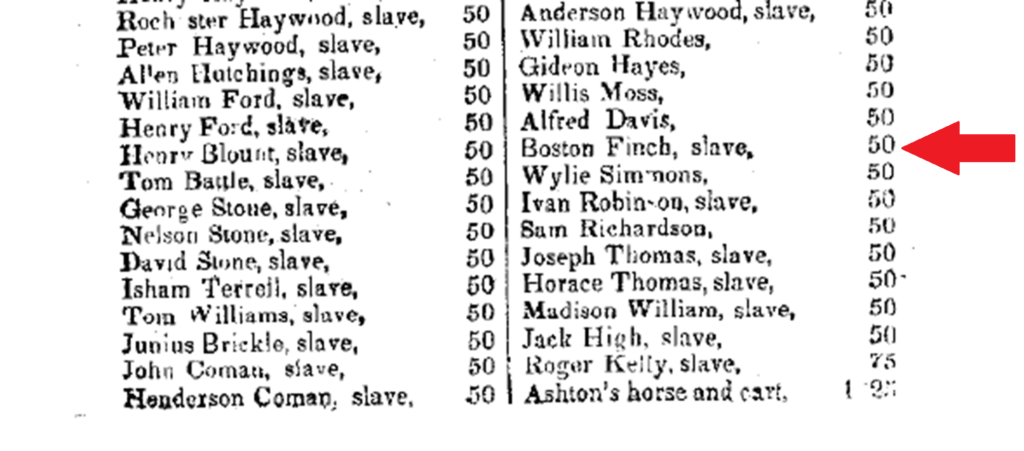
Boston Finch was born around 1800. Though we are unsure of many details of his early life, at some point he married his wife Harriett. He was listed on the 1834 Report of the Commissioners appointed to superintend the re-building of the State Capitol as a “laborer” compensated $.50 per day. Like most of the enslaved people on the Capitol project, Boston’s enslaver likely kept the money Boston’s labor generated.
In the 1834-36 Laborer’s Time Book, Boston’s compensation is signed for by “A.M. Haywood.” This was most likely Alfred M. Haywood, a member of the wealthy local Haywood family. In his father’s 1827 will, Alfred was given a tract of land along Walnut Creek in Wake County, but beyond that, we are unsure of his property holdings and therefore unsure where Boston may have lived.
Though many details of Boston’s life before the Civil War are not clear to us, after Emancipation, Boston is found in the records of the Freedmen’s Bureau. The Bureau of Refugees, Freedmen, and Abandoned Lands – most often referred to as the Freedmen’s Bureau – was established during the last days of the Civil War on March 3rd, 1865. The Bureau supervised all affairs relating to refugees, emancipated people, and recently abandoned lands or property. In Raleigh, they distributed rations to Freedmen like Boston.
Boston then appeared in local census records. 1870 was the first federal census to include formerly enslaved people. In 1870 and 1880, Boston was listed as a resident of House Creek Township in north-central Wake County. In 1870, Boston was listed as a gardener. He lived with his wife Harriett, who worked as a domestic servant, and fifteen year old Barbary Finch. The Finches also resided in a house with Sarah Buron, and her children James, Willie, and Eleanor. Sarah Buron might have been Boston and Harriett’s daughter.
By 1880, Boston and Harriett live on their own in the House Creek Township of Wake County. The census also listed Boston’s profession as a “laborer.”
In 1876, a local newspaper mentioned Boston in a “Local Matters” column. The Raleigh Daily Sentinel published an account of “Old Boston,” noting that he was “a very aged negro” who was seen in Raleigh, though he no longer lived there. The article talks about Boston’s recollections of Raleigh, including who was the prettiest girl Boston remembered. Though the article focuses on recognizing Boston and his memories, it is from the perspective of a conservative White newspaper and treats Boston as a caricature of a “good” (i.e. subservient and polite) Black person. It states that Boston was never “in a courthouse” and that he never “had a fight in his life.”
References:
- Capital Buildings records, State Archives of North Carolina.
- Ninth Census Of The United States, 1870, Record Group: Records of the Bureau of the Census, The National Archive, Washington, D.C.
- North Carolina Field Offices, Subordinate Field Offices: Raleigh, Lists of Rations Issues, Vol. 1 (227), 1865-67
- Report of the commissioners appointed to superintend the re-building of the State Capitol. Philo White, Printer to the State, Legislature of North Carolina, 1834. Accessed in the Raleigh History Collection, State Archives of North Carolina.
- Tenth Census Of The United States, 1880, Record Group: Records of the Bureau of the Census. The National Archive, Washington, D.C.
- The Raleigh Daily Sentinel (Raleigh, North Carolina), Friday, September 8, 1876.








